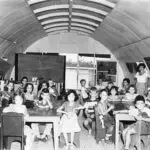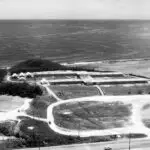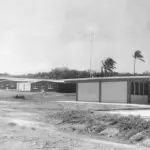Contract Teachers in the Classroom




Table of Contents
Share This
Culture clashes
In the years following the end of WWII in Guam, the naval administration, followed by a civilian administration in 1950, took on the great endeavor of building the government departments and agencies that served the island. Among the numerous challenges that this effort required was restructuring the island’s education system. One of the paramount issues in this was staffing schools with accredited teachers.
The initial response to this necessity for teachers came in the establishment of the Adelup Point Normal School in 1946. The goal of this school was to provide certification for a new generation of local teachers to enter into the workforce. In its first year of operation, 20 students had enrolled. In the next year, however, enrollment declined and the school was closed.
The Naval administration, in the meantime, turned its attention to recruiting faculty from the wives of locally stationed military officers, and bringing certified teachers to Guam from the US mainland.
Teachers, students face challenges
Teaching CHamoru/Chamorro students posed significant challenges for these teachers due to the cultural and language barrier. It also presented challenges for CHamoru students who were being taught by American teachers with American materials that had little relevance to island life. American teachers were also known to change CHamoru names to American nicknames such as calling Emilia Emily or calling Juan John. CHamoru students learned about Washington DC but not Hagåtña, about bears and wolves but not fanihi (fruit bat) and haggan (sea turtles).
Language use policies change
Despite requiring the use of English in classrooms and government facilities, CHamoru was maintained as the primary means of communication among the local population. An initial survey of first grade students in four selected schools around the island was conducted to assess English language skills. The results of this survey indicated that an overwhelming majority of students were noted to possess a skill level that was less than proficient. Some students were noted to possess no knowledge of how to use the English language whatsoever as the students had not been exposed to the language up to that point.
In 1950, Robert Johnson, a graduate student from Florida State University, visited Guam to research unique culturally relevant recommendations for the local education system as part of a report for his dissertation. The report was published and numerous recommendations to apply cultural understanding in local education. Among these were a more lenient stance on speaking CHamoru, taking advantage of the cultural value of community, and the incorporation of environmentally relevant material in course curriculum. Although these recommendations were not adopted by the schools, they further highlighted the fact that CHamoru students were placed at a serious disadvantage in their education.
Regardless, the singular use of English was still thoroughly enforced, both in instructional time and during breaks on the playground. This greatly affected CHamoru speaking students in two distinct ways. Not only were these students unable to fully grasp the subject content that was taught in English, but the lack of use of CHamoru in schools also prevented them from further developing their command of their native language.
Teachers were also faced with challenges associated with the gap in cultural differences. Throughout the island’s 50 years under an American administration, access to American literature and popular culture was severely limited. As a result, the typical American childhood that the teachers experienced was not often one shared by that of their students. This cultural disconnect was observed in the reading materials utilized by schools. Some of the books approved for instruction were “Fun With Dick and Jane,” “Our New Friends,” “New Neighbors,” and “Streets and Roads.” These books contained unfamiliar concepts and environments like cowboys, zoos, large cities, deserts, and the four seasons.
Education has community interest
Another cultural difference observed by contract teachers was the involvement many parents had in their school community. Local parents consistently assisted schools in campus maintenance and providing support during school events such as graduations and promotions. A great majority also regularly attended Parent Teacher Association meeting. These parents shared the same unfamiliarity with the English language and meetings had to have an interpreter present to ensure that they could be conducted in CHamoru as well as English. At Parent Teacher Association meetings, parents were urged by school faculty and administration to practice speaking English more with their children so they could perform better. As a result, many parents, wanting their children to succeed in school, began using CHamoru less and less at home.
As students graduated from school, their ability to communicate effectively in English made them more hirable. This further affected the local culture as many CHamorus, now able to get jobs, no longer needed to rely solely on subsistence farming to survive. Although many families did maintain some amount of farming, this new possibility of work shifted local culture away from one centered around an agrarian lifestyle.
Incorporating culture and environment into the classroom
Despite the initial rigidity in bringing an American style classroom to Guam by contract teachers, over the years many showed a willingness to incorporate aspects the local culture, language and environment into their work. Litie Chiles, a veteran contract teacher, encouraged new teachers to take advantage of strong relationship between the community and schools and visit the homes of their children before the school year began to meet the parents and establish rapport. This gesture was shown to increase parental involvement in ensuring their child listened to their teacher and worked as best as they could in their studies.
By the 1960s, speaking CHamoru was no longer a punishable offense, but rather was encouraged by teachers for students to use when talking to one another. In 1969, the island was granted funding via the Elementary and Secondary Education Act (ESEA) to incorporate CHamoru into select classrooms to serve as pilot classes for bilingual education. In this program, contract teachers were paired with local teachers who received training in CHamoru orthography. This allowed CHamoru to be used in up to 50 percent of instructional class time. These teachers worked together to determine the best subjects fit for teaching in English and CHamoru and worked with students in both languages.
Course curriculum was also encouraged to begin including examples that the average local student could identify with. Subjects like art were encouraged to use mediums such as weaving or carving within their course as many students were exposed to such in their daily lives. An example of this integration can be seen in the classes taught by Dr. Lawrence Cunningham, a contract teacher. In 1968, Cunningham was hired by the Guam Department of Education and was assigned to teach science at Agat Junior High. In his classes, Cunningham taught biology with examples of the local flora and fauna and illustrated geology by teaching about the creation of the Mariana islands. This helped to engage students as they were now able to see how their education could be applied to their understanding of their islands.
For further reading
Cunningham, Lawrence. “Guam Contract Hiring.” Interview by Lazaro Quinata. Modern Guam Rises from Destruction of War: 1945-1970, Guampedia. Hågat, Guam, 18 May 2021. Audio, 56:03.
Palomo, Rosa Salas. “Bilingual/ Bicultural Education Program on Guam.” Interview by Lazaro Quinata. Modern Guam Rises from Destruction of War: 1945-1970, Guampedia, 10 March 2021. Audio, 56:31.
Underwood, Robert A. “American Education and the Acculturation of the Chamorros of Guam.” EdD diss., University of Southern California, 1987.
US Naval Government of Guam. Quarterly Reports. Hagåtña: Naval Government of Guam,
1946-1949.
US Navy Department. Advisory Committee on Education for Guam and the Trust Territory of the Pacific Islands. Honolulu: NoD, 1949.
US Office of the Chief of Naval Operations. US Navy Report on Guam, 1899-1950. Washington, DC: OPNAV, 1951.
